返回:OpenCV系列文章目录(持续更新中......)
上一篇:OpenCV4.9的点多边形测试(65)
下一篇 :OpenCV4.9失焦去模糊滤镜(67)
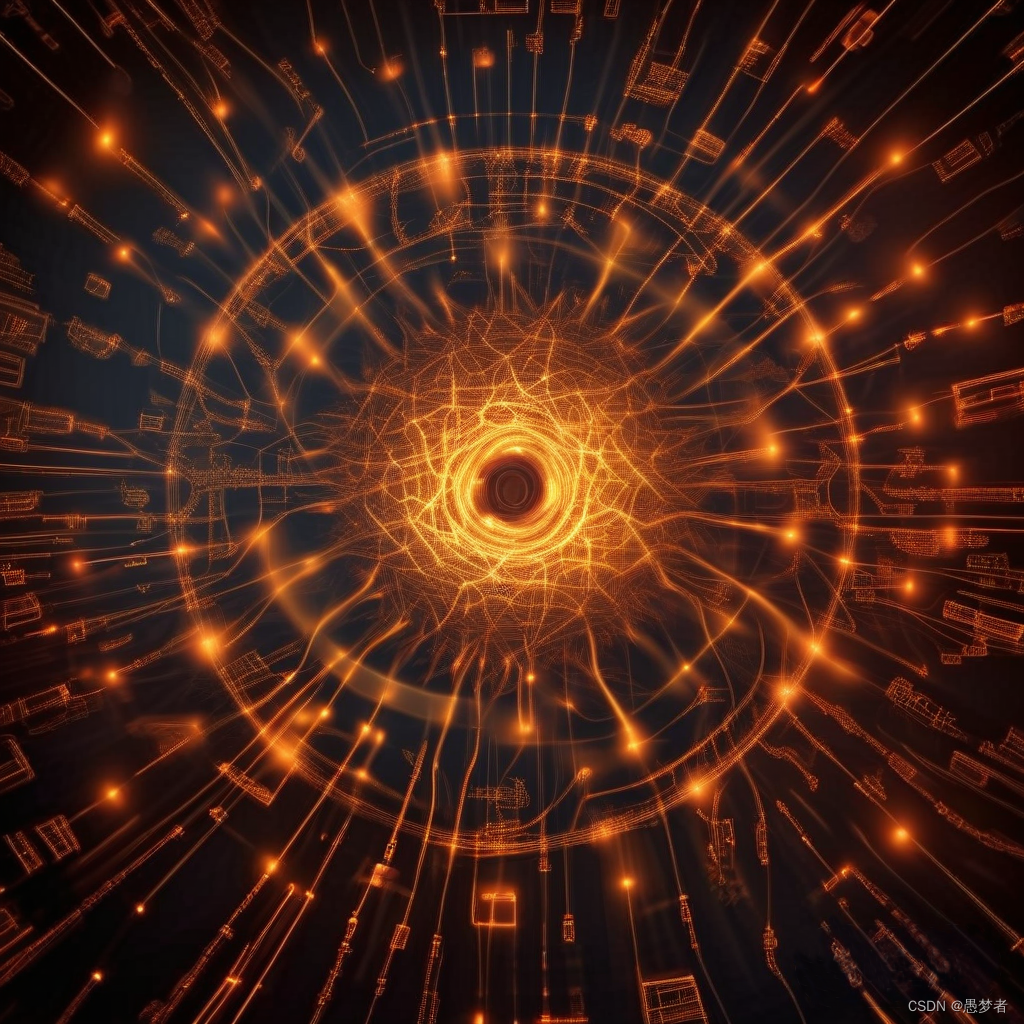
目标
在本教程中,您将学习如何:
- 使用 OpenCV 函数 cv::filter2D 执行一些拉普拉斯滤波以进行图像锐化
- 使用 OpenCV 函数 cv::d istanceTransform 获取二进制图像的派生表示,其中每个像素的值被替换为其到最近背景像素的距离
- 使用 OpenCV 函数 cv::watershed 将图像中的对象与背景隔离开来
OpenCV中基于距离变换和分水岭算法的图像分割可以通过以下步骤实现:
1. 对输入图像进行预处理,如去噪、二值化等。
2. 计算输入图像中每个像素的距离变换。距离变换可以指定基于欧式距离或者基于曼哈顿距离。
3. 根据计算的距离变换,确定输入图像中的每个像素点属于哪个区域。这可以通过分水岭算法实现。
4. 对图像进行分割并显示结果。
距离变换:
距离变换是一种用于图像分割的技术。它旨在确定每个像素点距离其最近非零点的距离,也称为距离图。距离变换的计算基于距离变换算子,可以使用不同的距离测量方法,例如欧几里得距离和曼哈顿距离等。
分水岭算法:
分水岭算法是一种基于图像处理的无监督分割技术,它是由Vincent和Soille于1991年提出的,并且在OpenCV中被广泛使用。其基本思想是把图像看成一个地形,将灰度值看作海拔。将图像中的某些像素点看成是水源,然后让水从这些点开始向外流,最终形成累积数、改变水流方向的水坝。
算法步骤:
(1) 对输入图像进行预处理操作。
(2) 计算输入图像的距离变换。
(3) 将距离变换作为分水岭算法的标记,标记初始化设置为0。
(4) 将标记与水坝合并,水从被选中的种子像素点开始向外流动,直到被周围区域的水坝拦住。
(5) 标记每个像素点所在的水坝并输出结果。
距离变换和分水岭算法结合起来,可以在图像分割方面提供有效的结果。这种技术可以用于医学图像处理、图像识别和计算机视觉等领域。
C++代码
本教程代码如下所示。您也可以从这里下载。
#include <opencv2/core.hpp>
#include <opencv2/imgproc.hpp>
#include <opencv2/highgui.hpp>
#include <iostream>
using namespace std;
using namespace cv;
int main(int argc, char *argv[])
{
// Load the image
CommandLineParser parser( argc, argv, "{@input | cards.png | input image}" );
Mat src = imread( samples::findFile( parser.get<String>( "@input" ) ) );
if( src.empty() )
{
cout << "Could not open or find the image!\n" << endl;
cout << "Usage: " << argv[0] << " <Input image>" << endl;
return -1;
}
// Show the source image
imshow("Source Image", src);
// Change the background from white to black, since that will help later to extract
// better results during the use of Distance Transform
Mat mask;
inRange(src, Scalar(255, 255, 255), Scalar(255, 255, 255), mask);
src.setTo(Scalar(0, 0, 0), mask);
// Show output image
imshow("Black Background Image", src);
// Create a kernel that we will use to sharpen our image
Mat kernel = (Mat_<float>(3,3) <<
1, 1, 1,
1, -8, 1,
1, 1, 1); // an approximation of second derivative, a quite strong kernel
// do the laplacian filtering as it is
// well, we need to convert everything in something more deeper then CV_8U
// because the kernel has some negative values,
// and we can expect in general to have a Laplacian image with negative values
// BUT a 8bits unsigned int (the one we are working with) can contain values from 0 to 255
// so the possible negative number will be truncated
Mat imgLaplacian;
filter2D(src, imgLaplacian, CV_32F, kernel);
Mat sharp;
src.convertTo(sharp, CV_32F);
Mat imgResult = sharp - imgLaplacian;
// convert back to 8bits gray scale
imgResult.convertTo(imgResult, CV_8UC3);
imgLaplacian.convertTo(imgLaplacian, CV_8UC3);
// imshow( "Laplace Filtered Image", imgLaplacian );
imshow( "New Sharped Image", imgResult );
// Create binary image from source image
Mat bw;
cvtColor(imgResult, bw, COLOR_BGR2GRAY);
threshold(bw, bw, 40, 255, THRESH_BINARY | THRESH_OTSU);
imshow("Binary Image", bw);
// Perform the distance transform algorithm
Mat dist;
distanceTransform(bw, dist, DIST_L2, 3);
// Normalize the distance image for range = {0.0, 1.0}
// so we can visualize and threshold it
normalize(dist, dist, 0, 1.0, NORM_MINMAX);
imshow("Distance Transform Image", dist);
// Threshold to obtain the peaks
// This will be the markers for the foreground objects
threshold(dist, dist, 0.4, 1.0, THRESH_BINARY);
// Dilate a bit the dist image
Mat kernel1 = Mat::ones(3, 3, CV_8U);
dilate(dist, dist, kernel1);
imshow("Peaks", dist);
// Create the CV_8U version of the distance image
// It is needed for findContours()
Mat dist_8u;
dist.convertTo(dist_8u, CV_8U);
// Find total markers
vector<vector<Point> > contours;
findContours(dist_8u, contours, RETR_EXTERNAL, CHAIN_APPROX_SIMPLE);
// Create the marker image for the watershed algorithm
Mat markers = Mat::zeros(dist.size(), CV_32S);
// Draw the foreground markers
for (size_t i = 0; i < contours.size(); i++)
{
drawContours(markers, contours, static_cast<int>(i), Scalar(static_cast<int>(i)+1), -1);
}
// Draw the background marker
circle(markers, Point(5,5), 3, Scalar(255), -1);
Mat markers8u;
markers.convertTo(markers8u, CV_8U, 10);
imshow("Markers", markers8u);
// Perform the watershed algorithm
watershed(imgResult, markers);
Mat mark;
markers.convertTo(mark, CV_8U);
bitwise_not(mark, mark);
// imshow("Markers_v2", mark); // uncomment this if you want to see how the mark
// image looks like at that point
// Generate random colors
vector<Vec3b> colors;
for (size_t i = 0; i < contours.size(); i++)
{
int b = theRNG().uniform(0, 256);
int g = theRNG().uniform(0, 256);
int r = theRNG().uniform(0, 256);
colors.push_back(Vec3b((uchar)b, (uchar)g, (uchar)r));
}
// Create the result image
Mat dst = Mat::zeros(markers.size(), CV_8UC3);
// Fill labeled objects with random colors
for (int i = 0; i < markers.rows; i++)
{
for (int j = 0; j < markers.cols; j++)
{
int index = markers.at<int>(i,j);
if (index > 0 && index <= static_cast<int>(contours.size()))
{
dst.at<Vec3b>(i,j) = colors[index-1];
}
}
}
// Visualize the final image
imshow("Final Result", dst);
waitKey();
return 0;
}解释/结果
- 加载源图像并检查它是否加载没有任何问题,然后显示它:
// Load the image
CommandLineParser parser( argc, argv, "{@input | cards.png | input image}" );
Mat src = imread( samples::findFile( parser.get<String>( "@input" ) ) );
if( src.empty() )
{
cout << "Could not open or find the image!\n" << endl;
cout << "Usage: " << argv[0] << " <Input image>" << endl;
return -1;
}
// Show the source image
imshow("Source Image", src);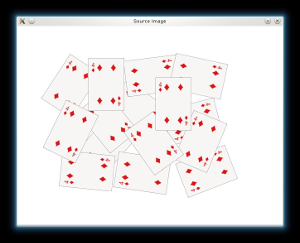
- 然后,如果我们有一个白色背景的图像,最好将其转换为黑色。这将帮助我们在应用距离变换时更容易地区分前景对象:
// Change the background from white to black, since that will help later to extract
// better results during the use of Distance Transform
Mat mask;
inRange(src, Scalar(255, 255, 255), Scalar(255, 255, 255), mask);
src.setTo(Scalar(0, 0, 0), mask);
// Show output image
imshow("Black Background Image", src);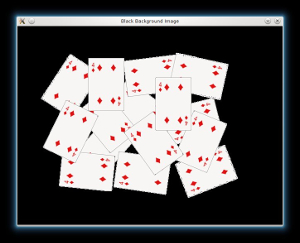
- 之后,我们将锐化图像,以锐化前景物体的边缘。我们将应用一个具有相当强滤波器的拉普拉斯滤波器(二阶导数的近似值):
// Create a kernel that we will use to sharpen our image
Mat kernel = (Mat_<float>(3,3) <<
1, 1, 1,
1, -8, 1,
1, 1, 1); // an approximation of second derivative, a quite strong kernel
// do the laplacian filtering as it is
// well, we need to convert everything in something more deeper then CV_8U
// because the kernel has some negative values,
// and we can expect in general to have a Laplacian image with negative values
// BUT a 8bits unsigned int (the one we are working with) can contain values from 0 to 255
// so the possible negative number will be truncated
Mat imgLaplacian;
filter2D(src, imgLaplacian, CV_32F, kernel);
Mat sharp;
src.convertTo(sharp, CV_32F);
Mat imgResult = sharp - imgLaplacian;
// convert back to 8bits gray scale
imgResult.convertTo(imgResult, CV_8UC3);
imgLaplacian.convertTo(imgLaplacian, CV_8UC3);
// imshow( "Laplace Filtered Image", imgLaplacian );
imshow( "New Sharped Image", imgResult );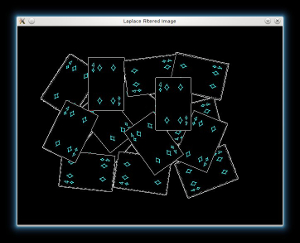
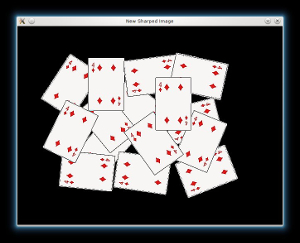
- 现在,我们将新的锐化源图像分别转换为灰度和二进制图像:
// Create binary image from source image
Mat bw;
cvtColor(imgResult, bw, COLOR_BGR2GRAY);
threshold(bw, bw, 40, 255, THRESH_BINARY | THRESH_OTSU);
imshow("Binary Image", bw);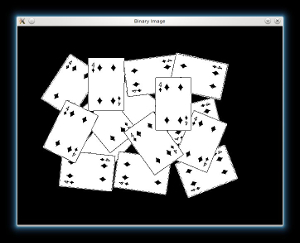
- 现在,我们已准备好在二进制图像上应用距离变换。此外,我们对输出图像进行归一化,以便能够对结果进行可视化和阈值:
// Perform the distance transform algorithm
Mat dist;
distanceTransform(bw, dist, DIST_L2, 3);
// Normalize the distance image for range = {0.0, 1.0}
// so we can visualize and threshold it
normalize(dist, dist, 0, 1.0, NORM_MINMAX);
imshow("Distance Transform Image", dist);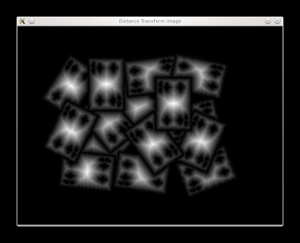
- 我们对dist图像进行阈值设置阈值,然后执行一些形态操作(即扩张),以便从上图中提取峰:
// Threshold to obtain the peaks
// This will be the markers for the foreground objects
threshold(dist, dist, 0.4, 1.0, THRESH_BINARY);
// Dilate a bit the dist image
Mat kernel1 = Mat::ones(3, 3, CV_8U);
dilate(dist, dist, kernel1);
imshow("Peaks", dist);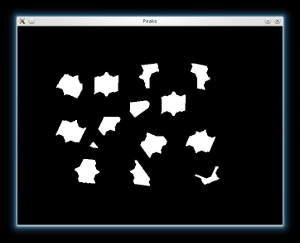
- 然后,我们借助 cv::findContours 函数为分水岭算法创建种子/标记:
// Create the CV_8U version of the distance image
// It is needed for findContours()
Mat dist_8u;
dist.convertTo(dist_8u, CV_8U);
// Find total markers
vector<vector<Point> > contours;
findContours(dist_8u, contours, RETR_EXTERNAL, CHAIN_APPROX_SIMPLE);
// Create the marker image for the watershed algorithm
Mat markers = Mat::zeros(dist.size(), CV_32S);
// Draw the foreground markers
for (size_t i = 0; i < contours.size(); i++)
{
drawContours(markers, contours, static_cast<int>(i), Scalar(static_cast<int>(i)+1), -1);
}
// Draw the background marker
circle(markers, Point(5,5), 3, Scalar(255), -1);
Mat markers8u;
markers.convertTo(markers8u, CV_8U, 10);
imshow("Markers", markers8u);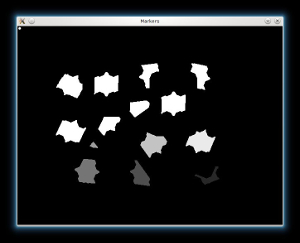
- 最后,我们可以应用分水岭算法,并将结果可视化:
// Perform the watershed algorithm
watershed(imgResult, markers);
Mat mark;
markers.convertTo(mark, CV_8U);
bitwise_not(mark, mark);
// imshow("Markers_v2", mark); // uncomment this if you want to see how the mark
// image looks like at that point
// Generate random colors
vector<Vec3b> colors;
for (size_t i = 0; i < contours.size(); i++)
{
int b = theRNG().uniform(0, 256);
int g = theRNG().uniform(0, 256);
int r = theRNG().uniform(0, 256);
colors.push_back(Vec3b((uchar)b, (uchar)g, (uchar)r));
}
// Create the result image
Mat dst = Mat::zeros(markers.size(), CV_8UC3);
// Fill labeled objects with random colors
for (int i = 0; i < markers.rows; i++)
{
for (int j = 0; j < markers.cols; j++)
{
int index = markers.at<int>(i,j);
if (index > 0 && index <= static_cast<int>(contours.size()))
{
dst.at<Vec3b>(i,j) = colors[index-1];
}
}
}
// Visualize the final image
imshow("Final Result", dst);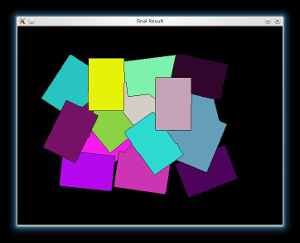
参考文献:
1、《Image Segmentation with Distance Transform and Watershed Algorithm》----Theodore Tsesmelis



























 被折叠的 条评论
为什么被折叠?
被折叠的 条评论
为什么被折叠?










